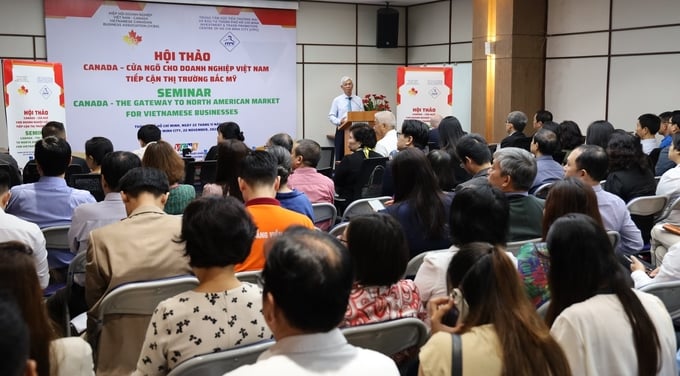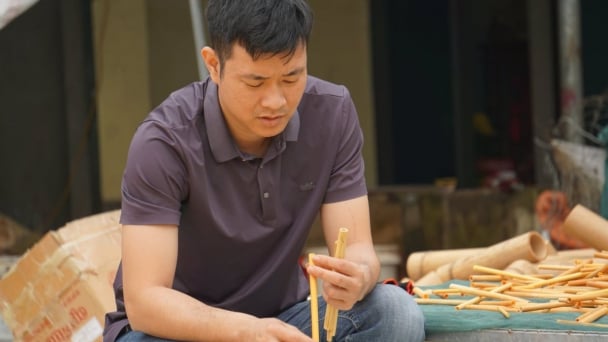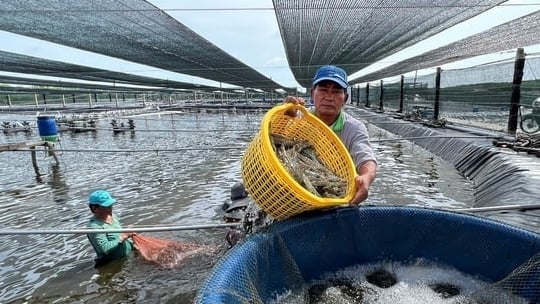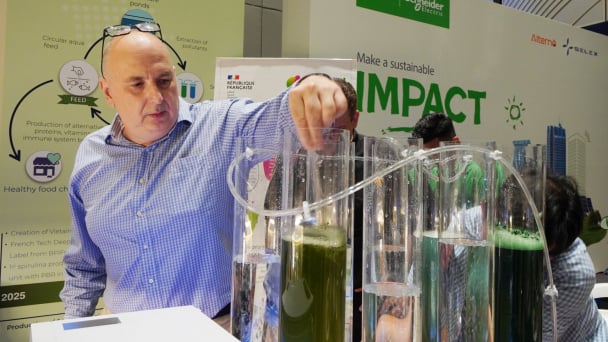May 29, 2025 | 15:40 GMT +7
May 29, 2025 | 15:40 GMT +7
Hotline: 0913.378.918
May 29, 2025 | 15:40 GMT +7
Hotline: 0913.378.918

A seminar organized by the Ho Chi Minh City Investment and Trade Promotion Center (ITPC) in collaboration with the Vietnam-Canada Business Association (VCBA). Photo: ITPC.
During the seminar on "Canada - The Gateway to North American market for Vietnamese businesses" held on November 22, Mr. Vo Van Hoan, Vice Chairman of Ho Chi Minh City People's Committee, shared that diversifying export markets, opening up new venues, and promoting underutilized potentials are crucial strategies to boost Vietnam's exports, especially within the current volatile global economic context. Notably, Canada has been considered as a potential target market and one of the most important partners for both Vietnam and Ho Chi Minh city.
Vietnam is currently Canada's leading trading partner in the ASEAN bloc and the sixth largest trading partner among the 40 countries in the Indian Ocean - Pacific.
According to Mr. Hoan, the seminar is a practical activity in trade promotion and support for Vietnamese exporting businesses. In addition to updating the latest market information and consumer trends in Canada, the seminar introduces an effective and practical networking channel for Vietnamese businesses in the Canadian market. Additionally, the event provides Vietnamese products with an extensive access into the Canadian market, a market full of potential but also poses challenges for exporting businesses.
"Ho Chi Minh City has consistently reaffirmed its commitment to fostering collaboration with businesses engaged in production and commercial activities. The Ho Chi Minh City Investment and Trade Promotion Center is actively collaborating with foreign affairs agencies, promotional units, as well as domestic and international business associations to organize practical initiatives aimed at promoting exports. These endeavors are designed to empower businesses in enhancing their export capacities," emphasized Mr. Hoan.
According to Mr. Nguyen Quang Trung, Consul General of Vietnam in Vancouver, Canada, Vietnam has remained as Canada's largest trading partner in the Southeast Asia for eight consecutive years. Namely, the total value of bilateral trade between Vietnam and Canada accounted for over one third of Canada's total trade with all countries within the ASEAN bloc in 2022. However, the bilateral trade relationship between Vietnam and Canada holds a relatively modest share, presenting an opportunity for Vietnamese investors.
"Vietnam's main export items to Canada include furniture, aquacultural products, handicrafts, plastic products, rubber, mobile phones, computers, textiles, and footwear," reported Mr. Trung. He further added that Canada is currently interested in the fields of education, infrastructure, financial investment, clean energy, and the export of agricultural products to Vietnam. In return, Canada's main export items to Vietnam include cereals, aquacultural products, coal, chemicals, medical equipment, meat products, fertilizers, seafood, wood products, soybeans, mineral fuels, and so on.
Ms. Cao Thi Phi Van, Deputy Director of ITPC, expressed her wish for Canada to create new opportunities for Vietnamese businesses by further expanding its market for Vietnamese goods, with a focus on agricultural products. She also emphasized the potential for cooperation in culture, sports, tourism, and people-to-people exchanges, thereby contributing to the enhancement of a comprehensive strategic partnership between the two countries.
Chairman Dan On of the Vietnam-Canada Business Association pledged that Canada will continue to support Vietnamese businesses by further expanding its market for Vietnamese goods, with exploration into the agricultural and aquacultural sectors, as well as fostering cooperation in culture, sports, tourism, and people-to-people exchanges.
Many experts believe that Vietnamese exporting and manufacturing businesses will enjoy multiple benefits in elevating their business activities by establishing branches and subsidiaries in Canada. Establishing a business presence in Canada not only provides an extensive access to the Canadian market but also creates a common platform for Vietnamese businesses to expand global export target markets and promote their brands internationally, with an emphasis on the North American market.
According to the General Department of Vietnam Customs, the import-export turnover between Vietnam and Canada is estimated at over 5.2 billion USD within the first ten months of 2023, representing a decrease of 16.3% compared to the same period in 2022. However, the total import-export turnover between Ho Chi Minh City and Canada reached nearly 633 million USD in 2022, with export turnover exceeding 470 million USD, representing an increase of 28% compared to the same period in 2021.
Under the framework of the Indo-Pacific Strategy, Canada aims to promote the establishment and negotiation of a free trade agreement with countries in the ASEAN bloc. Most notably, Canada plans to set up an agricultural office within ASEAN.
Translated by Nguyen Hai Long

(VAN) Ms. Nguyen Thi Dung, Deputy Director of Ngoc Hoang Cooperative, shared about the journey of bringing dragon fruit to Europe, achieving annual revenues in the billions of VND.

(VAN) Bamboo products from Thang Tho Bamboo Cooperative have reached many countries around the world, while also creating jobs for local workers.

(VAN) The Management Board of Con Dao National Park reported that a green sea turtle, tagged in the Philippines, has traveled thousands of kilometers to lay 84 eggs on Bay Canh Islet.

(VAN) Green technology is paving a new path for sustainable aquaculture in the Mekong Delta in particular and across the country in general, helping reduce emissions and adapt to climate change.

(VAN) On May 27, La French Tech Vietnam (the French startup and innovation community in Vietnam) held the French Tech Summit Vietnam 2025.
/2025/05/27/4731-2-223159_980.jpg)
(VAN) No votive paper, no styrofoam, no plastic bags, no plastic bottles, and no single-use plastic trays are the key rules tourists should keep in mind when visiting Con Dao.

(VAN) In the fight against plastic pollution, Vietnam has been demonstrating a proactive, pioneering, and active role in addressing the greatest environmental challenge today.